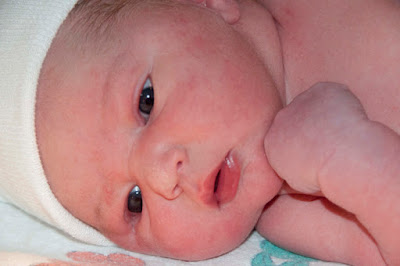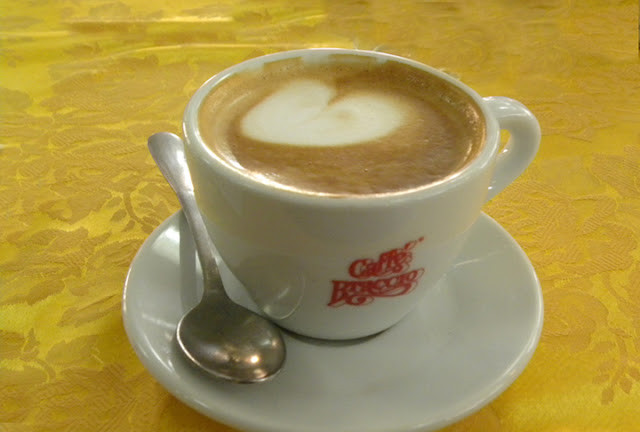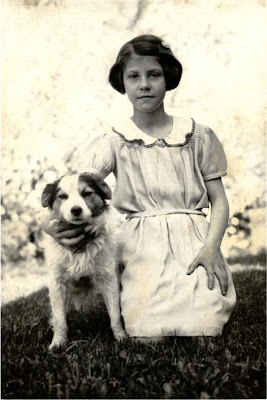Working on a Series
If you've taken Peggy Zehrings's workshops more than once, after the half-day of drawing blindfolded, you're free to mastermind your own abstract series. You have to articulate and write down a purpose, like "exploring form to form relationships" or "investigating the emotional impact of color." Then you write down the steps in the process you're adopting. The only requirement is that you design a process having at least five steps.
One of the big challenges of painting abstracts is to create a coherent composition that works while at the same time replicating the authentic nature of the drawings. So I set as my goal just that: to do a series that captured the freshness and truth inherent in the blindfolded drawings.
But how can you achieve that authenticity?
I've tried to use a blindfold when painting, but it doesn't work very well. Even though you can feel around to make sure you're staying on the canvas,you can't tell when your brush is dry. If you stick your brush into a jar blindfolded, you're likely to stick a black brush into the pink paint.
When I asked Peggy for suggestions, her answer was "TOOLS." So in all my paintings I used the following tools: a 4-inch brayer, the ridged foam for stamping, a stylus for scratching into the wet paint and various paintbrushes. I applied a thick goopy coat of gesso and after it dried, I inked up the brayer with some perfect grey I'd mixed. Then I put on the blindfold and made random roller marks. Before the paint was dry, I scratched marks into the wet paint. Then I used the foam thingy to stamp on the canvas. After that, I started painting the edges and in the spaces between the stamping and the brayering.
The first two paintings (24 x 36 inch canvases not pictured here) came like magic. That made me worry that I would hit a wall the next day because the first two were too easy. Self-limiting prophesy or intuition?
The next morning, I came in and brayered the remaining canvases. Forgot to scratch into the paint until it was too late. Started on the rest of the process.
And after a while they looked like this:

and this

The more I worked with them to try to bring them in line with the first two paintings, the less authentic they became. They started looking overworked and fussy to me -- the antithesis of what I was after. So I took pictures of the canvases and said goodbye to them. I gessoed over each canvas with another thick, mooshy layer of gesso to cover up the old paint.
Peggy said it was a gutsy move. Surprisingly, it was easy to let go of those two problem children because of my determination to have each piece be as spontaneous and uncontrived as possible.
While I was letting the two gessoed-over canvases dry, I picked up the fifth canvas, already brayered and stamped, and let 'er rip (the creative impulse, not the canvas).
It started like this

and less than an hour later, it looked like this:

It wasn't quite as strong as the first two, but strong enough, so it moved into position two, with the second one I painted as #1 and the first one I painted as #3 (the anchor) in the series. Tomorrow I'll show you how the last two canvases morphed into their final form and took their places as #4 and #5.
The series is called (I think) Personal Truth.
And one of my truths is that when we don't get it right the first time no matter how hard we try, we need to have the guts to let go and start fresh.
One of the big challenges of painting abstracts is to create a coherent composition that works while at the same time replicating the authentic nature of the drawings. So I set as my goal just that: to do a series that captured the freshness and truth inherent in the blindfolded drawings.
But how can you achieve that authenticity?
I've tried to use a blindfold when painting, but it doesn't work very well. Even though you can feel around to make sure you're staying on the canvas,you can't tell when your brush is dry. If you stick your brush into a jar blindfolded, you're likely to stick a black brush into the pink paint.
When I asked Peggy for suggestions, her answer was "TOOLS." So in all my paintings I used the following tools: a 4-inch brayer, the ridged foam for stamping, a stylus for scratching into the wet paint and various paintbrushes. I applied a thick goopy coat of gesso and after it dried, I inked up the brayer with some perfect grey I'd mixed. Then I put on the blindfold and made random roller marks. Before the paint was dry, I scratched marks into the wet paint. Then I used the foam thingy to stamp on the canvas. After that, I started painting the edges and in the spaces between the stamping and the brayering.
The first two paintings (24 x 36 inch canvases not pictured here) came like magic. That made me worry that I would hit a wall the next day because the first two were too easy. Self-limiting prophesy or intuition?
The next morning, I came in and brayered the remaining canvases. Forgot to scratch into the paint until it was too late. Started on the rest of the process.
And after a while they looked like this:

and this

The more I worked with them to try to bring them in line with the first two paintings, the less authentic they became. They started looking overworked and fussy to me -- the antithesis of what I was after. So I took pictures of the canvases and said goodbye to them. I gessoed over each canvas with another thick, mooshy layer of gesso to cover up the old paint.
Peggy said it was a gutsy move. Surprisingly, it was easy to let go of those two problem children because of my determination to have each piece be as spontaneous and uncontrived as possible.
While I was letting the two gessoed-over canvases dry, I picked up the fifth canvas, already brayered and stamped, and let 'er rip (the creative impulse, not the canvas).
It started like this

and less than an hour later, it looked like this:

It wasn't quite as strong as the first two, but strong enough, so it moved into position two, with the second one I painted as #1 and the first one I painted as #3 (the anchor) in the series. Tomorrow I'll show you how the last two canvases morphed into their final form and took their places as #4 and #5.
The series is called (I think) Personal Truth.
And one of my truths is that when we don't get it right the first time no matter how hard we try, we need to have the guts to let go and start fresh.



Comments
great post it seems that painting is loaded with life lessons.